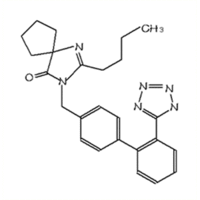Abstract
Irbesartan, an angiotensin II receptor antagonist (AIIRA), is an antihypertensive agent that inhibits the activity of angiotensin II by selectively binding to angiotensin II type 1 (AT1) receptors. The new onset of sustained periorbital, facial, and neck edema following the initiation of irbesartan therapy is described in a hypertensive 52-year-old woman. The patient's edema was not life threatening, remained unchanged following discontinuation of the medication, and persisted when treatment with the drug was subsequently reinstituted. Facial edema is a very uncommon adverse event that may occur in patients receiving irbesartan.
Introduction
Irbesartan, an angiotensin II receptor antagonist (AIIRA), is an effective drug for the treatment of mild to moderate essential hypertension (1,2). Mucocutaneous adverse reactions to this medication are uncommon (2,4). A woman with onset of persistent periorbital, facial, and neck edema that appeared following the initiation of irbesartan therapy is described.
Case Report
A 240 pound 52-year-old White woman presented with an elevated blood pressure of 185/100. For the preceding year, she had been receiving 50 mg of atenolol daily to treat her hypertension. Her daily atenolol was continued and irbesartan was started at a dose of 150mg each day. Her blood pressure returned to normal and remained at 135/80.
Approximately 2 months after irbesartan therapy was started, the patient noted the progressive and sustained puffiness of her eyelids and the more subtle swelling of her face and neck. However, she did not recognize the temporal association between the onset of her symptoms and the initiation of irbesartan.
Two years after starting irbesartan she still weighed 240 pounds. Physical examination showed prominent bilateral edema of the upper and the lower eyelids. Her face and neck were also edematous (Figures 1a, 1b). There was no swelling of her lips, tongue, uvula, or pharynx. There was also no peripheral edema of her arms or legs. Additional discussion elicited the relationship between her beginning irbesartan and the subsequent onset of her periocular, facial, and neck edema.
[FIGURE 1 OMITTED]
She discontinued the irbesartan. Her blood pressure increased and there was no improvement of her edema. Within 2 months, she restarted the irbesartan; her blood pressure again returned to normal range. At follow-up 2 years later, she is still taking daily irbesartan, her blood pressure is not elevated, and her edema of the eyelids, face, and neck remains unchanged.
Discussion
AIIRAs are a class of antihypertensive agents that include candesartan cilexetil, eprosartan, irbesartan, losartan, telmisartan, and valsartan. Stimulation of the angiotensin II receptors of the AT1 subtype results in blood pressure elevation. The AIIRAs reduce the known physiological effects of angiotensin II by selectively binding to the AT1 receptors (1-6).
Treatment with irbesartan is generally well tolerated by patients. The incidence of side effects, derived from the pooled data from nine placebo-controlled clinical trials involving 2606 patients, showed no clinically relevant variation between the irbesartan recipients (n=1965) and the placebo recipients (n=641) (1-3). Edema (peripheral) and rash were noted in about 28 irbesartan recipients (1.43%) and 23 irbesartan recipients (1.16%), respectively (2); however, these adverse events occurred more frequently in patients receiving placebo: approximately 15 patients (2.32%) developed edema and 13 patients (2.03%) developed rash (2,3). Other mucocutaneous side effects (facial edema, upper extremity edema, dermatitis, ecchymosis, facial erythema, pruritus, and urticaria) occurred in at least 5 (0.3%) but less than 1.0% of the 1965 patients who received irbesartan (3).
During the post-marketing experience, angioedema (involving swelling of the face, lips, pharynx, and/or tongue) and urticaria have very rarely been reported in patients treated with irbesartan (3). Angioedema has also been observed in patients receiving other AIIRAs, such as losartan (1,4,6,7) and valsartan (7). Some of the patients with losartan-associated angioedema had previously experienced angioedema with an angiotensin converting enzyme (ACE) inhibitor; the onset of their AIIRA-induced angioedema was delayed, ranging from 2 to 3 weeks after starting treatment (6,7).
The temporal association between the reported patient's starting irbesartan and the subsequent onset of her periocular, facial, and neck edema strongly suggests a causative relationship. She had not received prior treatment with an ACE inhibitor and she never developed swelling of her lips, tongue, uvula or pharynx. Her edema did not diminish after she discontinued the irbesartan and it has remained unchanged with continued irbesartan therapy.
Conclusion
Facial edema is an uncommon adverse event that may appear in patients receiving irbesartan. Rarely, angioedema has occurred in irbesartan treated patients. The irbesartan-associated eyelid, face, and neck edema of the reported patient was not life threatening. However, her edema was persistent, not only after the drug had been discontinued, but also following the reinstitution of the medication.
References
(1.) Burnier M. Angiotensin II type 1 receptor blockers. Circulation 2001; 103:904-912.
(2.) Gillis JC, Markham A. Irbesartan: a review of its pharmacodynamic and pharmacokinetic properties and therapeutic use in the management of hypertension. Drags 1997; 54:885-902.
(3.) Avapro (irbesartan). In: Physicians' Desk Reference. 56 edition. Montvale, New Jersey. Medical Economics Company, Inc. 2002:1073-1076.
(4.) Wong W, Howes L. Angiotensin receptor antagonists. Aust Fam Physician 2000; 29:653-658.
(5.) Kaplan NM. Angiotensin II receptor antagonists in the treatment of hypertension. Am Fam Phisician 1999; 60:1185-1190.
(6.) Kirk JK. Angiotensin-II receptor antagonists: their place in therapy. Am Fam Physician 1999; 59:3140-3148.
(7.) Pylypchuk GB. ACE inhibitor--versus angiotensin II blocker--induced cough and angioedema. Ann Pharmacother 1998; 32:1060-1066.
ADDRESSS FOR CORRESPONDENCE:
Philip R. Cohen, MD
805 Anderson Street
Bellaire, Texas 77401-2806
Tel: 713-667-8343
E-mail: mitehead@aol.com
PHILIP R. COHEN, MD
UNIVERSITY OF HOUSTON HEALTH CENTER, HOUSTON, TEXAS, AND THE DEPARTMENT OF DERMATOLOGY, UNIVERSITY OF TEXAS-HOUSTON MEDICAL SCHOOL, HOUSTON, TEXAS.
COPYRIGHT 2002 Journal of Drugs in Dermatology
COPYRIGHT 2003 Gale Group



